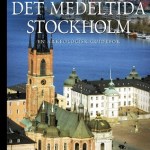History
The Stone of Sälna is a runestone (U 323) erected about AD 1000 at Sälna hamlet where a major road crossed Hargsån stream in Skånela parish, Uppland. (This is not far from where Arlanda airport now sprawls.) None of this is unusual. But the stone's great height, its inscription and its later fate are. Here's what can be made out of the runes as they survive today and as documented by a 17th century antiquarian.
Østeinn and Jorundr and Bjorn, the brothers, erected [this] stone [after] ...steinn drums, their father. God help his spirit and soul, forgive him his crimes and sins. Forever shall…
Every so often, real life intrudes on blogging, preventing the creation of fresh Insolence, at least Insolence of the quality that you've come to expect. This is one of those times, thanks to three grant deadlines. So enjoy this bit of Classic Insolence from back in November 2010 and be assured that I'll be back tomorrow. Remember, if you've been reading less than three and a half years, it's new to you, and, even if you have been reading more than two and a half years, it's fun to see how posts like this have aged.
Every so often, the reality of trying to maintain a career in science-based…
This is priceless. There's a line of scented candles and other spa treatment paraphernalia called Voluspa. Volu-spa, get it? Now, the firm shows no awareness of what their chosen name means. Völuspá is a long Old Norse poem in the Poetic Edda, dealing with the creation and eventual destruction (and re-creation) of the world. It's title means "Prophecy of the Seeress", and it's known as one of the most majestic pieces of writing in its language. With this name, the candlemakers are either just oblivious, or they're judging that their target market doesn't know much about the Viking Period.
I…
"Twinkle, twinkle, quasi-star
Biggest puzzle from afar
How unlike the other ones
Brighter than a billion suns
Twinkle, twinkle, quasi-star
How I wonder what you are." -George Gamow
The Big Bang is one of the greatest, revolutionary ideas in all of modern science, but it's also one of the most successful ideas as far as making predictions that have aligned with our observations of the Universe. Despite all of that, there are a whole bunch of people who'll read this (and more who won't) who aren't sure that the Big Bang is correct. Some people, in fact, don't even understand the definition…
Historiska media is a publishing house in Lund. In recent years they have been putting out pop-sci guide books about Medieval Sweden, province by province. I've reviewed the volumes about Södermanland and Uppland provinces here. And now my friend and Fornvännen co-editor Elisabet Regner has written the first volume in the series that deals with a town, not a province: about Stockholm, in whose suburbs I've lived for almost all my life. Together with the Uppland and Södermanland volumes, Det medeltida Stockholm gives us Stockholmers a pretty good grip on our Medieval surroundings.
I shouldn't…
I've never been able to figure it out. Antivaccine zealots seem to have an intense love of Nazi analogies and comparing those supporting science-based medicine to Nazis. While from a strictly nasty point of view, I can sort of understand the utility of such analogies to demonize one's opponents. After all, to political extremists of nearly all stripes (excluding actual real neo-Nazis, of course) Adolf Hitler is the gift that keeps on giving. Antiwar activists liked to try to tar George W. Bush with the Hitler appellation, and, now that Barack Obama is in power, right wing Tea Party types have…
Chalk one up for the forces of anti-science, quackery, and pseudoscience. The citizens of Portland, Oregon just handed them a huge victory the other day when they once again rejected water fluoridation in a referendum:
Fluoride supporters, it appeared, had everything going for them.
Five Portland city commissioners had voted to add fluoride to the city water supply. Health advocacy groups, and many of the city's communities of color, lined up behind the cause. And proponents outraised opponents 3-to-1.
But none of that was enough. For the fourth time since 1956, Portlanders on Tuesday night…
A few years ago I did some fieldwork at Djurhamn, a peripheral naval harbour of the 15th through the 17th centuries (and blogged much about it: A - B - C - D - E - F - G - H, and published a paper on it in an anthology). Now maritime archaeologist Jonas Wiklund has published a paper on the sad fate of the Rikswasa, a nearby shipwreck that was salvaged by a diving firm and made into coffee-table ornaments in the 1960s with permission from the National Maritime Museum. Jonas has kindly allowed me to make his paper (in Swedish) available here on Aard.
Wiklund, J. 2013. Rikswasa -- från…
I found something pretty wild in an essay by J.L. Borges this morning. There's a 13th century Norse saga about the Buddha. And the story has other fine twists as well. This all revolves around a legendary tale of the Buddha's early life.
In the 6th century BC a son was born to a petty king in what is now Nepal. He was named Siddharta, and it was prophesied shortly after the boy's birth that he would become either a great king or a great holy man. His father then kept him carefully protected from contact with religion and human suffering, apparently to keep the boy away from the holy-man…
It's very clear that many antivaccinationists hate autistic children. The language they use to describe them makes that very clear. Such children are "damaged" (by vaccines, of course); the parents' real children were "stolen" from them (by vaccines); they are "toxic" (from vaccines); the "light left their eyes" (due to vaccines). Autism is an "epidemic," a "tsunami," even a "holocaust," with "denial" of that "holocaust" being equivalent to Holocaust denial. All of this likens autism to a horror on par with these calamities, and paints vaccines as the instrument of annihilation of…
Earlier today, Maggie Koerth-Baker posted this tweet:
I dig this graph, but I think it misses an outreach opportunity by ascribing common misconceptions to creationists only bouncingdodecahedrons.tumblr.com/post/17808416988
It links to a diagram showing evolution as a linear path rather than a branching tree, and it got me thinking about terribly popular misconceptions about evolution that were started by smart people, and a doozy came to mind. A whole collection of doozies, actually, from one single terribly clever person.
You've all heard the stupid creationist objection to evolution — "if…
In this well-written, painstakingly annotated and beautifully designed book, physicist Baruch Sterman (with contributor Judy Taubes Sterman) traces the history and prehistory of a certain blue pigment, along with its cultural and religious significance through the ages. It's what the Torah and Talmud calls tekhelet, and it's made from a gland harvested from Murex sea snails.
Though greatly interested in history, archaeology and biology, I find myself poorly equipped to engage with the book's subject matter. Or put differently, I don't think I'm part of its intended audience. Because there's a…
There are many fallacies that undergird alternative medicine, which evolved into "complementary and alternative medicine" (CAM), and for which the preferred term among its advocates is now "integrative medicine," meant to imply the "best of both worlds." If I had to pick one fallacy that rules above all among proponents of CAM/IM, it would have to be either the naturalistic fallacy (i.e., that if it's natural—whatever that means—it must be better) or the fallacy of antiquity (i.e., that if it's really old, it must be better). Of course, the two fallacies are not unrelated. In the minds of CAM…
In honor of the 125th anniversary of The American Physiological Society, a history of its founding was just published in Advances in Physiology Education. It reads like a Who's Who list of some of the most important contributors to our understanding of modern physiology. Where would physiology research be in this country without this important society and the hard work of its founding fathers?
Founders of The American Physiological Society from Ryan, 2013
To read more about these pioneering men, and the history of physiology in the US, click here.
Source:
Ryan KL. APS at 125: a look back…
Sweden used to have its own version of Irish Coffee: kaffekask. It was big in the 19th century and I believe it dropped from favour during our 1917-55 period of liquor rationing. Nobody seems to drink kaffekask anymore.
A kask is a type of helmet like the ones worn by English bobbies. But that's apparently not the etymology of kaffekask. More likely it comes from Low German karsch, "harsh", "abrasive".
Kaffekask consists only of coffee and 40% (70° proof) potato schnapps plus optionally a sugar cube per cup. Swedish schnapps (brännvin, "burn wine") is usually flavoured and does not to my…
I really hate to write this post, but I feel compelled. The reason I hate to write it is because someone I admire screwed up. The reason I feel compelled is because of my longstanding interest in World War II and Holocaust history, not to mention my longtime interest in refuting the lies of Holocaust deniers. I had meant to write about it the first time I came across it, but for some reason did not. I don't remember the reason, although it might very well be because of how much I respect the person who wrote it. Again, I don't remember, and today it really doesn't matter why. Whatever the…
Karl Olausson has just submitted his Bachelor's thesis in history: a study of the post-WW2 Swedish boardgame market. The material he's used is largely interviews with people in our country's boardgame business. Karl has kindly given me permission to put the work on-line (in Swedish). Here's the abstract:
This essay is about the history of the Swedish board game-industry from the 1970’s to today. The essay focuses on the companies in the business and how they change during this period and about the causes of this change. This essay aims both at accurately describing the development of the…
Jonathan Fetter-Vorm's Trinity: A Graphic History of the First Atomic Bomb is a real gem of a graphic novel, yet another stunning exemplar of what is possible with the graphic novel format.
As I've often said, there are basically two kinds of science graphic novels -- those that use the format to illustrate the same content as a textbook would have on the theory that anything illustrated must be more accessible and enjoyable. And those that use the graphic novel format to its fullest, finding a new way to bring science to a mass audience. The latter, of course, if preferable. But I have to…
Ferdinand Balfoort contributes a guest entry upon a recent ancestral pilgrimage to Stockholm.
I gladly agreed to write something for the blog after being introduced by Martin to a book by Frans G. Bengtsson about Early Modern Scottish brigades (and brigadiers) in the Nordic region including Sweden. I visited Stockholm in December on my quest to find my 16th century ancestor Gilbert Balfour who lost his head during a public decapitation procedure with a sharp implement, somewhere in the Old Town. So far I am no closer to retrieving his head or his grave site, but some illumination has been…
"This one will look like a jellybean," the session director warns us. "Or, you know, when you empty a hole punch? The circles of paper that fall out? One of those." She's talking about Neptune, and I am about to step, carefully, up a ladder painted industrial yellow and wheeled into place in front of the centenarian eyepiece of the 60" Hale telescope at Mt. Wilson Observatory, incidentally the very place where Edwin Hubble, in 1925, discovered that our galaxy was not the entirety of the Universe, and later, that our Universe was expanding.
A jellybean, a piece of confetti: it seems her…










